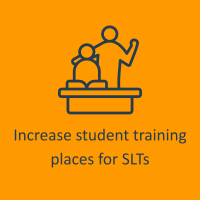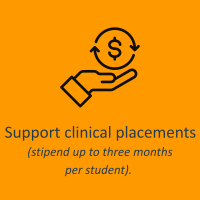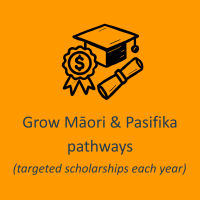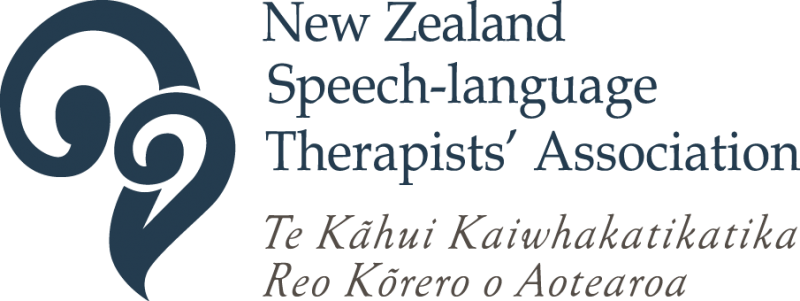Our Position: Grow the Speech-language Therapy workforce



Our first three priorities
What we want:
- Fund 20 additional speech-language therapists (SLTs) for one year (Financial Year 26/27) to clear a significant backlog in the provision of assistive technology and alternative augmentative communication (AT/AAC) for New Zealanders living with disabilities.
- Provide ongoing funding of 10 SLTs a year from Year two (Financial Year 27 onwards), to maintain equitable and timely access to this technology.
Why it matters:
- Augmentative communication and assistive technology are critical enablers that improve the quality of life, offer choice, and support agency.
- The gap lies in specialist AAC SLTs. Funding 20 SLTs (year one) clears a 3+ year waitlist of ~1,650 people; 10 SLTs are ongoing to maintain timely access.
- Timely AAC lifts learning and employment, preventing issues from escalating.
![]() Providing essential Assistive Technology
Providing essential Assistive Technology
and Alternative Augmentative Communication
(AT/AAC) technology to help disabled New Zealanders
live with dignity and better participate in society.
What we want:
- Fund ten dementia specialist SLTs nationwide.
Why it matters:
- Communication and swallowing problems are common in dementia; without timely SLT, people become isolated, are admitted to hospital with aspiration/dehydration, enter residential care earlier, and whānau carers burn out.
- The service gap is stark and demand is rising: 83,000 people live with dementia now, heading towards ~170,000 by 2050, yet there is just 0.5 FTE dedicated SLT in one region—leaving thousands without essential support and costs climbing.
- Funding 10 specialist SLTs nationwide embeds early, proactive support that keeps people engaged, supports safe eating, reduces hospitalisations, delays residential care, and sustains carers—at about $1.12m per year with savings from avoided admissions and delayed placements.
What we want:
- Fund 23.3 SLT FTE speech-language therapists (SLTs)
to be directly employed or panel-contracted across all
community residential care services for under-65s.
Why it matters:
- Residents are unsafe and unheard now: SLT is delayed and reactive; support staff lack training—leading to preventable choking, avoidable admissions, and barriers to communication.
- Funding 23.3 SLT FTE embeds proactive support—safer eating, fewer ED/hospitalisations, and fewer crises and complaints.
- Small cost, big payoff—and it upholds rights to communication, participation, and health.
Frequently asked questions
NZSTA is calling on the Government to make sure all New Zealanders can eat, drink, communicate and live safely, no matter their age, disability, or where they live. Right now, too many people are missing out on the speech-language therapy support they need. The manifesto outlines practical, affordable steps to fix this.
SLTs help people communicate, understand others, and swallow safely. Their work prevents hospitalisations, supports independence, helps children learn, and protects basic human rights — like being able to express pain, ask for help, or make decisions about your own life.
Across New Zealand, access to speech-language therapy depends on where you live, which agency you’re dealing with, and whether the local workforce has enough staff.
This leads to:
- Years-long waitlists for assistive communication technology
- Disabled people in residential care at risk of preventable choking and harm
- People with dementia going without essential communication and swallowing support
- Whānau experiencing significant stress because help is not available.
Doing nothing costs more in hospital admissions, residential placements, and crisis responses.
NZSTA is asking Government to fund a modest increase in SLT staffing in three key areas:
- Assistive Technology & AAC – 20 SLTs in year one, then 10 each year ongoing
- Dementia care – 10 dementia specialist SLTs nationwide
- Residential disability services (under 65s) – 23.3 SLTs to make homes safe to eat and communicate in
These are targeted, specialist roles where small investments will prevent harm and reduce pressure in the broader health system.
More SLTs in the system means:
- Faster access to assistive devices that allow disabled people to communicate
- Safer eating and drinking for thousands of people in residential care
- People with dementia staying connected and independent for longer
- Reduced hospitalisations
- Better support for whānau and carers
- Significant savings to Vote Health and Disability Support Services
AAC devices and tools enable many disabled people to communicate, learn, work, and participate.
But people currently wait more than three years for assessment, and over 1,600 people are on the waiting list. SLTs are the only professionals who can design the personalised communication systems these devices rely on.
Dementia affects 83,000 New Zealanders, and this number will nearly double by 2050. Communication and swallowing problems are common among this community, but right now we have just 0.5 SLT FTE dedicated to dementia care in one region.
SLTs help people stay connected, reduce hospitalisations, and delay entry to aged residential care.
More than 6,000 disabled New Zealanders under 65 live in residential homes, most with significant swallowing or communication challenges. Without SLT support, preventable choking events, hospital admissions and communication breakdowns are increasing. Funding 23.3 SLTs would ensure every home has proactive, regular support.
No. The total investment is about $4.8 million a year, with a one-off year of extra funding for AAC waitlist clearing. This is a tiny fraction of the health budget and will save money by preventing hospitalisations and reducing crisis-level interventions.
Evidence from the position papers shows:
- AT/AAC funding has a 4:1 social return
- Delayed residential care entry saves tens of thousands per person
- Preventing a single aspiration admission or PEG placement saves significant cost
- Avoiding repeated ED visits in disability care reduces pressure on hospitals
- Early SLT intervention reduces downstream crisis responses
- Health NZ community SLTs are already overstretched
- Disability sector SLT coverage is inconsistent and often absent
- Education pathways rely heavily on TalkLink and lack sustained follow-through
- Dementia SLT coverage is almost non-existent
- Rural regions face chronic gaps
Current structures are simply not designed to meet growing complexity or volume.
We know there are gaps and shortages in speech-language therapy right across Aotearoa – in health, education, disability and aged care. This manifesto focuses on three priority areas for the 2026 election because they are places where a small, targeted increase in SLT staffing will make a big, measurable difference quickly.
These three areas were chosen because:
- The risks are high – people are currently missing out on basic safety, communication and dignity.
- The fixes are clear – we know exactly what extra SLT roles are needed and where they would sit.
- The impact is system-wide – better support for AAC, dementia, and residential disability care will reduce hospitalisations, crises and pressure on other services.
This is a first step, not the full solution. NZSTA will keep working with Government on the wider SLT workforce shortage and will bring further proposals in future years as part of a longer-term plan.
That communication and swallowing are essential to life and dignity, and the services that protect these functions are not optional extras.
A small increase in SLT capacity in three high-need areas will:
- Prevent avoidable harm
- Reduce health system costs
- Improve quality of life
- Support whānau
- Deliver equitable, culturally responsive care
It is a practical, affordable and urgent plan.



